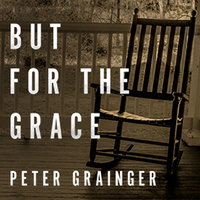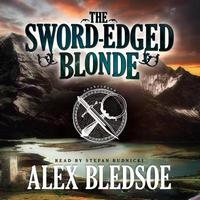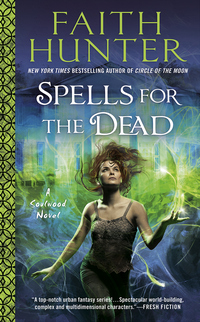 |
Spells for the Deadby Faith Hunter eARC, 384 pg. Read: July 13, 2020 |

What’s Spells for the Dead About?
PsyLED is called to the home of a country music superstar to investigate some mysterious deaths—the and her band had recently returned from a pretty successful tour and now many of them are dead and several of those who aren’t are in desperate need of First Responders to act quickly.
Sadly, no First Responder is equipped to cope with whatever happened to them, much less recognize and understand it. That goes for people later to the scene, including PsyLED. However, under the direction of T. Laine, their witch, they’re able to makes some guesses about treatment. Nell, Occam and Lainie focus on documenting everything they can as well as beginning preliminary interviews.
One of the first things they determine is that a witch was not behind this attack. Sadly, they reach this conclusion too late to prevent a local sheriff, with the aid of a less than ethical senior FBI agent, to lock up the band member who is a witch. Their logic is impeccable—paranatural crime, arrest the nearest paranatural. This anti-paranatural tendency shows up frequently among the humans in this book—particularly when it comes to witches. I appreciated the way that Lainie dealt with it (both in her more honest and then in her more politic approaches). Our trio being joined by their upline boss, Ayatas FireWind, helps in this manner somewhat (both because of his rank, and FireWind’s general demeanor).
On a semi-related note, you would think that people who believe/proclaim very loudly that lycans, witches, vampires, and so one are horrible monsters that want to kill all humans would be a little more circumspect when they’re around. Maybe it’s just me, but if I thought someone wanted to rip my limbs off and snack on them, I would go out of my way to not antagonize them.
Anyway, the team’s focus here is a little split—on the one hand, they need to both identify the type of magic behind the attack and continue to find better ways to treat those fighting off the effects; and on the other, figure out who had the motive and/or means to carry it out. Neither goal was really that easy.
So That’s the Main Story, What Else is Going On?
As with all books in this series, as much as this is about the PsyLED team, it’s really about Nell Ingram, her integration into the world outside the cult she left, even as she continues to deal with it and her family. God’s Glory Church really doesn’t factor heavily in this book, but it’s always in the back of her mind, shaping (either directly or in reaction to it) how she reacts to things.
There is a pretty intense moment related to the Church, but it has more to do with Nell’s family, than the Church itself. Nell doesn’t yet have full custody of Mud, but everyone’s pretty much acting as if she does. Mud’s continuing to settle in and push Nell in ways she wasn’t prepared for. Which is just fun. Both Nell and Mud are having to deal with their very pregnant sister, Esther. Esther’s pregnancy is causing her powers (and flowers) to come forward, and unlike her sisters, she’s not that interested in them. It’s a nice contrast—and it provides Mud with some great opportunities for growth.
On the work side, the team’s recent successes—particularly as the only predominately non-human team in PsyLED—are causing the Agency to make some changes to the way the Agency works—and this is going to spill over onto the team. By and large, the changes look positive and will provide good opportunities for the various members of the team. However, Nell doesn’t like change—doubly so when it applies to those things in her life she holds most dear. And since we read all this from her perspective, it’s hard to look objectively at all this.
If we’re looking at the Venn Diagram of Nell’s families (natural and found), the overlap is Occam. I’ve always loved this relationship, and now that they’re openly seeing each other and professing love? Occam’s so good, saying all the right things, doing all the right things, he’s practically a Gary Stu/Marty Stu. That “practically” there is important—Hunter’s written him in such a way over these few books that he comes across as earnest in all this, he’s not perfect, he’s just really close to perfect for Nell. They’re just fun together.
As for Nell herself? She’s continuing to work on herself, her approach to life. She makes some wise decisions and actions with her relationship with FireWind. She makes some great leaps with the relationship (if you can call it that) with the Vampire Tree. And we get some of the most solid information on just what kind of paranatural creature Nell is (watching her stifle her curiosity on this front to focus on the case was a great moment). Basically, Spells for the Dead contains more of that sure and steady, organic character development that’s been the hallmark of this series.
So what did I think about Spells for the Dead?
One of my favorite parts of these books is Nell’s reactions to new-to-her foods. We don’t see her introduced to anything here, but we still get to see her relish a few things she wasn’t exposed to for most of her life—Krispy Kreme donuts and pizza. This is actually kind of a good way to think about most of this book—unlike the previous books (particularly the first two), we’re not seeing Nell experience much that’s new here—mostly she’s living in this new world, rather than figuring things out. Hunter has established her world, has set up the characters, creatures, overarching conflicts, and whatnot. Now she gets to play with that world.
This means (at least for me, and at least for this book), that without the earth-shattering reveals, the Big Moments in Nell’s (or other characters’) life, the book has less of an impact on me. Spells for the Dead is just as good as the rest of the series has been, it just doesn’t hit me the same way. Which leads to a slightly lower rating. Hunter’s plotting, writing, and characters are still top-notch, it just didn’t blow me away. I got to spend some time with some really good friends—and I’m so happy I did—but it was comfortable, not exploratory. I trust that won’t always be the case, and that Hunter will certainly do things in this series that will cause my jaw to drop, but sometimes it’s simply going to be a really good/great novel instead of a fantastic one. Still making it one of the best series I follow.
I really got into this case—it wasn’t as fraught as some of the previous ones were, but it was interesting and unexpected. The side stories did everything they needed to. Spells for the Dead just solidifies the Soulwood books as one of the best UF series going.

My thanks to Let’s Talk! Promotions for the invitation to participate in this tour and the materials (including the book via NetGalley and Berkley Publishing Group) they provided.
![]()


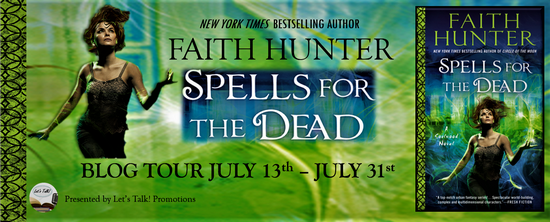
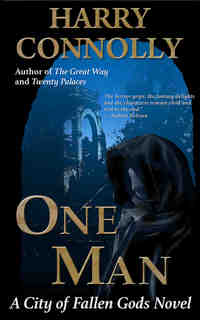

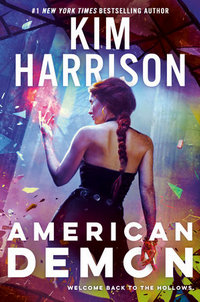
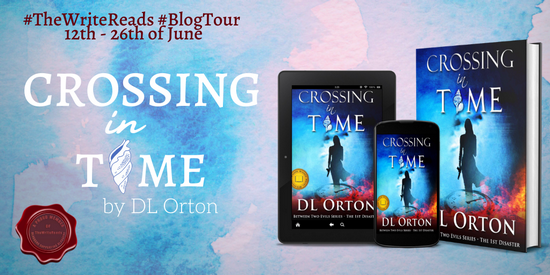
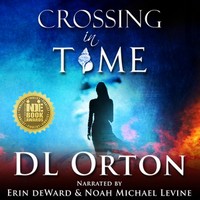


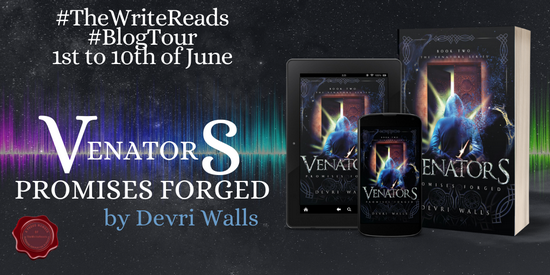
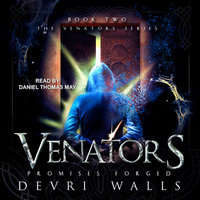
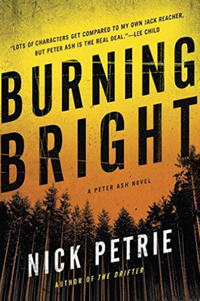
 At multiple points both Peter and June note that Peter’s having fun when it’s dangerous, when things are violent, when the bullets are flying. As a reader, this is great—you don’t see Reacher, Charlie Fox, Evan Smoak, etc. enjoying things quite like this. But I’m a little worried about what it says about him as a person.
At multiple points both Peter and June note that Peter’s having fun when it’s dangerous, when things are violent, when the bullets are flying. As a reader, this is great—you don’t see Reacher, Charlie Fox, Evan Smoak, etc. enjoying things quite like this. But I’m a little worried about what it says about him as a person.
